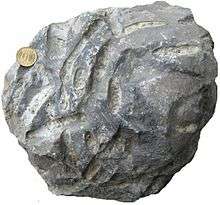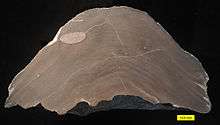Osprioneides
| Osprioneides | |
|---|---|
 | |
| Trace fossil classification | |

Osprioneides is an ichnogenus of unbranched, elongate borings (a type of trace fossil) in lithic substrate with oval cross−section, single−entrance and straight, curved or irregular course. Osprioneides kampto Beuck and Wisshak, 2008 is the largest known Palaeozoic boring trace. It occurs in the Ordovician and Silurian (Wenlock) of Baltica. [1] The borings are up to 120 mm long measuring 5–17 mm in diameter (Beuck et al., 2008) . The distribution of Osprioneides is more environmentally limited than that of Trypanites in the Silurian of Saaremaa, Estonia (Baltica). Osprioneides probably occurred only in large hard substrates of relatively deepwater muddy bottom open shelf environments. Osprioneides were relatively rare, as compared to Trypanites-Palaeosabella borings in the Wenlock of Saaremaa.[2]
References
- ↑ Vinn, O; Wilson, M.A., Mõtus, M.-A. (2014). "The Earliest Giant Osprioneides Borings from the Sandbian (Late Ordovician) of Estonia". PLoS ONE: 9(6): e99455. doi:10.1371/journal.pone.0099455. Retrieved 2014-06-07. Cite uses deprecated parameter
|coauthors=(help) - ↑ Vinn, O.; Wilson, M.A. (2010). "Occurrence of giant borings of Osprioneides kampto in the lower Silurian (Sheinwoodian) stromatoporoids of Saaremaa, Estonia". Ichnos. 17: 166–171. doi:10.1080/10420940.2010.502478. Retrieved 2014-06-10.
- Beuck, L., Wisshak, M., Munnecke, A., and Freiwald, A. (2008). "A giant boring in a Silurian stromatoporoid analyzed by computer tomography". Acta Palaeontologica Polonica 53: 149–160.